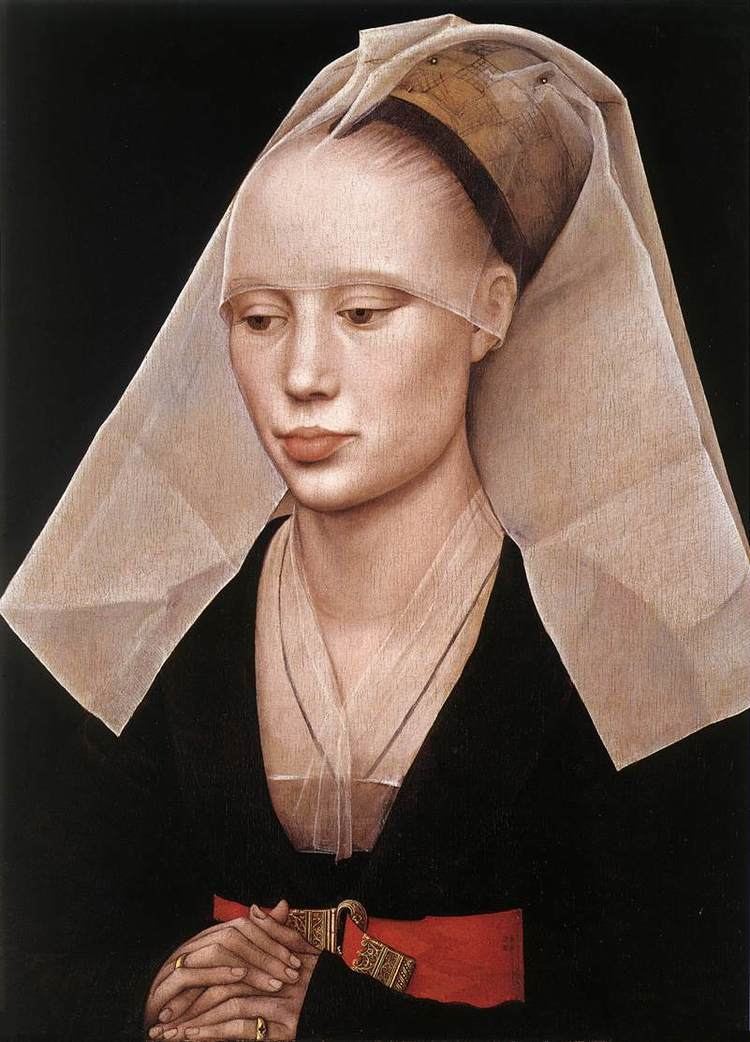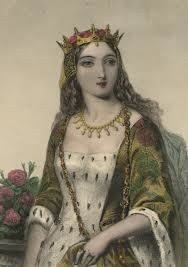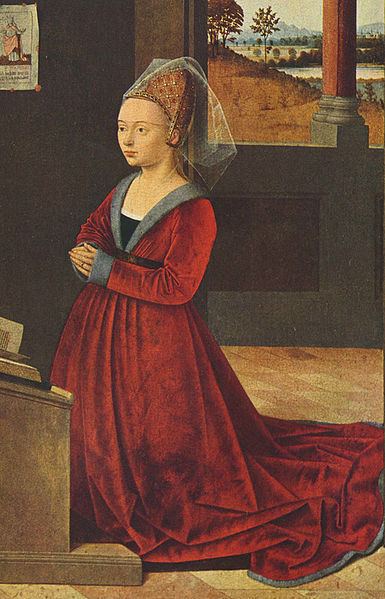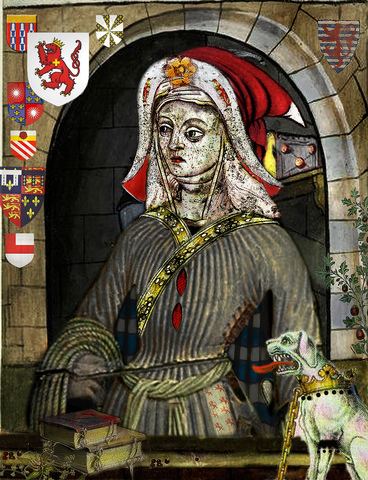Name Jacquetta Luxembourg | Father Peter I of Luxembourg | |
Issue Elizabeth Woodville, Queen consort of EnglandLouis WoodvilleAnne WoodvilleAnthony Woodville, 2nd Earl RiversMary WoodvilleJacquetta WoodvilleJohn WoodvilleRichard Woodville, 3rd Earl RiversMartha WoodvilleEleanor WoodvilleLionel WoodvilleMargaret WoodvilleEdward Woodville, Lord ScalesCatherine Woodville, Duchess of Buckingham Similar People Richard Woodville - 1st Earl R, Elizabeth Woodville, Anthony Woodville - 2nd Earl, John of Lancaster - 1st Duke, Elizabeth of York Died 30 May 1472 (aged 55–57) Born 1415/16 (age 55–57) | ||
Jacquetta of Luxembourg, Countess Rivers (1415/1416 – 30 May 1472) was the eldest daughter of Peter I of Luxembourg, Count of Saint-Pol, Conversano and Brienne, and his wife Margaret of Baux (Margherita del Balzo of Andria). She was a prominent, though often overlooked, figure in the Wars of the Roses. Through her short-lived first marriage to the Duke of Bedford, brother of King Henry V, she was firmly allied to the House of Lancaster. However, following the emphatic Lancastrian defeat at the Battle of Towton, she and her second husband Richard Woodville sided closely with the House of York. Three years after the battle and the accession of Edward IV of England, Jacquetta's eldest daughter Elizabeth Woodville married him and became Queen consort of England. Jacquetta bore Woodville 14 children and stood trial on charges of witchcraft, for which she was exonerated.
Contents
- Rivers Family
- Family and ancestry
- Early life
- First marriage
- Second marriage
- Wars of the Roses
- Witchcraft accusations
- Heritage
- Children
- In fiction
- References

River's Family
Family and ancestry

Her father Peter of Luxembourg, Count of Saint-Pol, was also the hereditary Count of Brienne from 1397 until his death in 1433. Peter had succeeded his father John of Luxembourg, Lord of Beauvoir and mother Marguerite of Enghien, who had been Count and Countess of Brienne from 1394 to her death in 1397. John had been a fourth-generation descendant of Waleran I of Luxembourg, Lord of Ligny, second son of Henry V of Luxembourg and Margaret of Bar. This cadet line of the House of Luxembourg held Ligny-en-Barrois.

Jacquetta's paternal great-grandmother, Mahaut of Châtillon, was descended from Beatrice of England, daughter of King Henry III of England and Eleanor of Provence. Jacquetta's mother, Margherita del Balzo, was a daughter of Francesco del Balzo, 1st Duke of Andria, and Sueva Orsini. Sueva descended from Simon de Montfort, 6th Earl of Leicester and Eleanor of England, the youngest child of King John of England and Isabella of Angoulême.

The Luxembourgs claimed legendary descent from the water deity Melusine through their ancestor Siegfried of Luxembourg (AD 922-998). Jacquetta was a fourth cousin twice removed of Sigismund of Luxembourg, the reigning Holy Roman Emperor and king of Bohemia and Hungary.
Early life
Most of Jacquetta's early life is a mystery. She was born as the Lancastrian phase of the Hundred Years War began. Her uncle, John II of Luxembourg, Count of Ligny, was the head of the military company that captured Joan of Arc. John held Joan prisoner at Beauvoir and later sold her to the English.
First marriage

On 22 April 1433 at age 17, Jacquetta married John of Lancaster, 1st Duke of Bedford at Thérouanne. The Duke was the third son of King Henry IV of England and Mary de Bohun, and thus the grandson of John of Gaunt, 1st Duke of Lancaster, himself the third son of King Edward III. The marriage was childless and the Duke died on 15 September 1435 at Rouen. As was customary at the time, after her second marriage Jacquetta retained the title of her first husband and was always known as the Duchess of Bedford, this being a higher title than that of countess. Jacquetta inherited one-third of the Duke's main estates as her widow's share.
Second marriage
Sir Richard Woodville, son of Sir Richard Woodville who had served as the late Duke's chamberlain, was commissioned by Henry VI of England to bring Bedford's young widow to England. During the journey, the couple fell in love and married in secret (before 23 March 1437), without seeking the king's permission. Jacquetta had been granted dower lands following her first husband's death on condition that she did not remarry without a royal licence. On learning of the marriage, Henry VI refused to see them, but was mollified by the payment of a fine of £1000. The marriage was long and very fruitful: Jacquetta and Richard had fourteen children, including the future Queen Consort Elizabeth Woodville. She lost her first-born son Lewis to a fever when he was 12 years old.

By the mid-1440s, the Woodvilles were in a powerful position. Jacquetta was related to both King Henry and Queen Margaret by marriage. Her sister, Isabelle de Saint Pol, married Margaret's uncle Charles du Maine while Jacquetta was the widow of Henry VI's uncle. She outranked all ladies at court with the exception of the queen. As a personal favourite, she also enjoyed special privileges and influence at court. Margaret influenced Henry to create her husband Baron Rivers in 1448, and he was a prominent partisan of the House of Lancaster as the Wars of the Roses began.
Wars of the Roses
The Yorkists crushed the Lancastrians at the Battle of Towton on 29 March 1461, and Edward IV, the first king from the House of York, took the throne. The husband of Jacquetta's oldest daughter Elizabeth, Sir John Grey, had been killed a month before at the Second Battle of St. Albans, a Lancastrian victory under the command of Margaret of Anjou. At Towton, however, the tables turned in favour of the Yorkists.
Edward IV met and soon married the widowed Elizabeth Woodville in secret; though the date is not accepted as exactly accurate, it is traditionally said to have taken place (with only Jacquetta and two ladies in attendance) at the Woodville family home in Northamptonshire on 1 May 1464. Elizabeth was crowned queen on 26 May 1465. The marriage, once revealed, ruined the plans of Richard Neville, Earl of Warwick, Edward's cousin, who had been negotiating a much-needed alliance with France via a political marriage for Edward.
With Elizabeth now Queen of England, the Woodvilles rose to great prominence and power. Jacquetta's husband Richard was created Earl Rivers and appointed Lord High Treasurer in March 1466. Jacquetta found rich and influential spouses for her children and helped her grandchildren achieve high posts. She arranged for her 20-year-old son, John, to marry the widowed and very rich Katherine Neville, Duchess of Norfolk, who was at least 45 years older than John. The rise of the Woodvilles created widespread hostility among the Yorkists, including Warwick and the king's brothers George and Richard, who were being displaced in the king's favour by the former Lancastrians.
In 1469, Warwick openly broke with Edward IV and temporarily deposed him. Earl Rivers and his son John were captured and executed by Warwick on 12 August at Kenilworth. Jacquetta survived her husband by three years and died in 1472, at about 56 years of age.
Witchcraft accusations
Shortly after her husband's execution by Warwick, Thomas Wake, a follower of Warwick’s, accused Jacquetta of witchcraft. Wake brought to Warwick Castle a lead image “made like a man-of-arms . . . broken in the middle and made fast with a wire,“ and alleged that Jacquetta had fashioned it to use for witchcraft and sorcery. He claimed that John Daunger, a parish clerk in Northampton, could attest that Jacquetta had made two other images, one for the king and one for the queen. The case fell apart when Warwick released Edward IV from custody, and Jacquetta was cleared by the king’s great council of the charges on February 21, 1470. In 1484 Richard III in the act known as Titulus Regius revived the allegations of witchcraft against the dead Jacquetta when he claimed that she and Elizabeth had procured Elizabeth's marriage to Edward IV through witchcraft; however, Richard never offered any proof to support his assertions.
Heritage
Through her daughter Elizabeth, Jacquetta was the maternal grandmother of Elizabeth of York, wife and queen of Henry VII, and therefore an ancestor of all subsequent English monarchs.
Children
- Elizabeth Woodville, Queen consort of England (c. 1437 – 8 June 1492), married first Sir John Grey, second Edward IV of England.
- Lewis Woodville (c. 1438), died in childhood.
- Anne Woodville (1438/9 – 30 July 1489), married first William Bourchier, Viscount Bourchier, second Sir Edward Wingfield, third George Grey, 2nd Earl of Kent.
- Anthony Woodville, 2nd Earl Rivers (c. 1440 – 25 June 1483), married first Elizabeth Scales, 8th Baroness Scales, second Mary Fitzlewis; not married to Gwenllian Stradling, the mother of Margaret.
- John Woodville (c. 1444 – 12 August 1469), married Catherine Neville, Dowager Duchess of Norfolk.
- Jacquetta Woodville (1445–1509), married John le Strange, 8th Baron Strange of Knockin.
- Lionel Woodville, Bishop of Salisbury (c. 1446 – June 1484).
- Eleanor Woodville (d. c. 1512), married Sir Anthony Grey, son of Edmund Grey, 1st Earl of Kent.
- Margaret Woodville (c. 1450 – 1490/1), married Thomas Fitzalan, 17th Earl of Arundel.
- Martha Woodville (d. c. 1500), married Sir John Bromley.
- Richard Woodville, 3rd Earl Rivers (1453 – March 1491).
- Edward Woodville, Lord Scales (1454/8 – 28 July 1488).
- Mary Woodville (c. 1456 – 1481), married William Herbert, 2nd Earl of Pembroke.
- Catherine Woodville (c. 1458 – 18 May 1497), married first Henry Stafford, 2nd Duke of Buckingham, second Jasper Tudor, Duke of Bedford.
The Visitation of Buckinghamshire of 1566 mentions the marriage of William Dormer of Wycombe (only later of Ascott House) to "Agnes, da. of Sir Richard Woodvyle, Erle Ryvers" but does not say whether the father was the first or the third earl, who the mother was or whether Agnes was legitimate.
In fiction
Jacquetta is a main character in Philippa Gregory's 2009 novel The White Queen, a fictionalized account of the life of her eldest daughter Elizabeth. In the novel, Jacquetta is portrayed as having indeed dabbled quite a bit in witchcraft, displaying what would seem to be actual power. She is also the main protagonist in Gregory's 2011 prequel novel The Lady of the Rivers. Gregory's works explore the historical claim by Jacquetta's family that they were descended from the water deity Melusine. Gregory uses Jacquetta's tenuous ties to Melusine and Joan of Arc to further her potential ties to witchcraft. In the 2013 BBC One/Starz television series adaptation The White Queen, Jacquetta is portrayed by actress Janet McTeer.
Jacquetta is also an important character in Margaret Frazer's fifth "Player Joliffe" novel, A Play of Treachery (2009). The story is set in 1435–6, after the death of her first husband, John, Duke of Bedford. This historical novel tells a tale regarding her marriage to Sir Richard Woodville. There is no mention of witchcraft in this novel.
Jacquetta is also a prominent character in The Last of the Barons (1843), a novel by Edward Bulwer-Lytton (1803–1873). The book's title is a reference to Richard Neville, Earl of Warwick.
